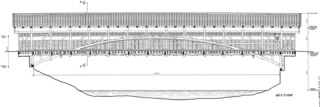 | Back to e-WV
| Back to e-WV
 The West Virginia Encyclopedia
The West Virginia Encyclopedia
 | Back to e-WV
| Back to e-WV
 The West Virginia Encyclopedia
The West Virginia Encyclopedia

The covered bridge was a central European invention adopted and perfected in North America. It has been estimated that more than 10,000 were built across the United States between 1805 and 1900. The total number of covered bridges built in Western Virginia is unknown. Harrison County alone once had more than 50. In 1959, a census of America’s covered bridges listed 47 still in existence in the Mountain State. That number had fallen to 17 by 2023.
The remaining covered bridges can be found at Philippi and Carrollton, Barbour County; Center Point, Doddridge County; Herns Mill and Hokes Mill, Greenbrier County; Fletcher and Simpson Creek, Harrison County; Staats Mill and Sarvis Fork, Jackson County; Locust Creek, Pocahontas County; Walkersville, Lewis County; Barrackville, Marion County; Indian Creek and Laurel Creek, Monroe County; Dents Run, Monongalia County; and Fish Creek, Wetzel County. The Mud River Covered Bridge at Milton, Cabell County, was moved from its original location and rebuilt at Pumpkin Park.
Turnpikes sanctioned by the commonwealth of Virginia made it necessary to build many of the region’s bridges, which were covered to protect the timber framing from the weather. The bridge building fell to an eclectic group of entrepreneurs, who began with timber and one basic design element, the triangular truss, and changed American bridge design for the next 100 years.
Most bridge builders were local self-taught master carpenters with extraordinary skills. Among the best-known were Lemuel Chenoweth and James Moore. Chenoweth built most of the bridges in the central portion of the Staunton-Parkersburg Turnpike, including the ones at Philippi and Barrackville. Moore supervised the major crossings of the Gauley and Greenbrier rivers along the James River & Kanawha Turnpike.
The craftsmanship displayed in the construction of these spans is represented in the painstaking mortising, fitting, and pegging. The intricate truss patterns were named for the clever men who designed them. Theodore Burr, famous for the Burr arch truss, patented his system in 1817. The Barrackville and Carrollton covered bridges are examples of the Burr design, which integrated an arch into the truss framework. Several West Virginia bridges used the Long truss, a system of boxed X’s patented by Col. Stephen H. Long in 1830. These bridges include Staats Mill and Sarvis Fork, with Center Point, Hokes Mill, and Indian Creek representing modifications of the Long truss. The Philippi bridge, one of only six remaining two-lane covered bridges in the United States, is unusual in that the builder employed the Long design in conjunction with a double arch system.
The Warren double-intersection truss was patented in Britain by James Warren and T. W. Morzani in 1838. The Locust Creek covered bridge is the only remaining example of this design in West Virginia. William Howe was granted a patent in 1840 for substituting vertical rods in place of some wooden tension members. The Mud River covered bridge is the last remaining example of a Howe truss on a covered bridge in West Virginia.
Other truss designs, including kingpost, multiple kingpost, and queenpost, are also represented in the state’s surviving covered bridges. The kingpost is the oldest and simplest design, consisting of a simple triangular truss dating back to the Middle Ages. The Dents Run and Fish Creek covered bridges both use the kingpost truss. A version of the kingpost, known as the queenpost, was modified by the addition of a horizontal cross-supporting member to allow for greater spans. The Walkersville, Laurel Creek, and Herns Mill covered bridges all use the queenpost truss. Another modified version of the kingpost is the multiple kingpost. This design allowed even greater spans by adding more triangular sectional units to the trussing system, as shown in the Fletcher and Simpson Creek covered bridges.
The covered bridges that remain possess intrinsic beauty and charm, a testimony to the craftsmanship of their builders. Their practical straightforward design created long-lasting structures, which have survived the gales of war, floods, ice, and even grievous fires over the past century and a half.
Written by Todd A. Hanson
Cohen, Stan. West Virginia's Covered Bridges. Charleston: Pictorial Histories Publishing Company, 1992.
Allen, Richard Sanders. Covered Bridges of the Mid-Atlantic States. Brattleboro, VT: Stephen Green Press, 1959.
Auvil, Myrtle. Covered Bridges of West Virginia. Parsons: McClain, 1972.